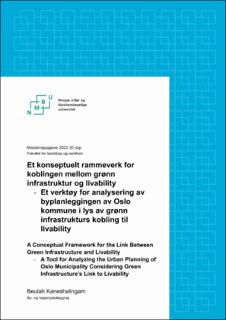| dc.contributor.advisor | Marino, Mina Di | |
| dc.contributor.author | Kaneshalingam, Beulah | |
| dc.date.accessioned | 2023-02-03T17:27:08Z | |
| dc.date.available | 2023-02-03T17:27:08Z | |
| dc.date.issued | 2022 | |
| dc.identifier | no.nmbu:wiseflow:6726303:52487193 | |
| dc.identifier.uri | https://hdl.handle.net/11250/3048403 | |
| dc.description.abstract | Grønn infrastruktur (GI) i byen er under stadig trussel med tanke på dagens vektlegging av fortetting innenfor eksisterende byggesone. Fortetting er ofte begrunnet med argumentet om at økt fortetting innad i byen, fører til ivaretakelse og vern av GI utenfor byggesonen. På den andre siden er det også en økende bevissthet om GI sine funksjoner og tjenester til urbane miljøer gjennom eksempelvis overvannshåndtering og tilførsel av biologisk mangfold. Rekreasjon og friluftsliv er også sosiale og relasjonelle funksjoner ved GI som menneskene i byen kan dra nytte av. Koblingen mellom GI og livability (beboelighet) er dermed viktig å fremheve med tanke på dagens utfordringer som klimaendringer og menneskelig velvære i en kompakt by. Denne avhandlingen har sett på hvordan koblingen mellom GI og livability har kommet frem i litteraturen og i byplanleggingen av Oslo kommune.
Oppgavens metoder består av integrativ litteraturstudie og kvalitativ innholdsanalyse av overordnede og kommunale plandokumenter. Litteraturstudien som viser koblingen mellom GI og livability har dannet grunnlaget for utvikling av et rammeverk for å evaluere sammenhengen i byplanleggingen av Oslo kommune. Den kvalitative innholdsanalysen er utført med utgangspunkt i det konseptuelle rammeverket som er utviklet. Studien av de utvalgte plandokumentene viser at det ofte påpekes at fortetting er en faktor som kan påvirke GI i planlegging av bymiljøet i Oslo kommune negativt, men fortettingsstrategien er fortsatt førende for byutviklingen. Oppgavens funn viser at det er både eksplisitte og implisitte koblinger mellom GI og livability i alle plandokumentene, men det er kommuneplanens samfunnsdel som har størst bredde i behovene og aspektene ved livability som er identifisert. Det er de sosiale og helsemessige funksjonene ved GI som fremheves mest på tvers av plandokumentene.
Det konseptuelle rammeverket som er utviklet kan benyttes til både evaluering av eksisterende planer og som en pekepinn på hva som kan vektlegges generelt i nye planer. Rammeverket bør fortsatt være gjenstand for videreutvikling av konseptene og ytterligere empirisk testing. Likevel kan dette rammeverket være ansett som et forsøk på en kontekstualisering mellom oppgavens konsepter, og et utgangspunkt for videre forskning. | |
| dc.description.abstract | Green infrastructure (GI) in the city is under constant threat in view of the current emphasis on densification within the existing construction zone. Densification is often justified with the argument that increased densification within the city leads to safeguarding and protection of GI outside the construction zone. On the other hand, there is also an increasing awareness of GI's functions and services to urban environments through, for example, stormwater management and the addition of biodiversity. Recreation and outdoor life are also social and relational functions of GI that the people in the city can benefit from. The link between GI and livability is thus important to highlight in view of today's challenges such as climate change and human well-being in a compact city. This thesis has looked at how the link between GI and livability has emerged in the literature and in the urban planning of Oslo municipality.
The methods of the thesis consist of an integrative literature study and qualitative content analysis of overall and municipal planning documents. The literature study that shows the link between GI and livability has formed the basis for the development of a framework to evaluate the connection in the urban planning of Oslo municipality. The qualitative content analysis has been conducted based on the conceptual framework that has been developed. The study of the selected planning documents shows it is often emphasized that densification is a factor that can negatively affect GI in planning the urban environment in Oslo municipality, but the densification strategy is still leading for urban development. The findings of the assignment show that there are both explicit and implicit links between GI and livability in all planning documents, but it is the municipal plan that has the greatest coverage in the needs and aspects of livability that has been identified. It is the social and health functions of GI that are emphasized the most across the planning documents.
The conceptual framework that has been developed can be used both for the evaluation of existing plans and as a pointer to what can be emphasized in general in new plans. The framework should continue to be subject to further development of the concepts and further empirical testing. Nevertheless, this framework can be considered an attempt to contextualize the thesis' concepts, and a starting point for further research. | |
| dc.language | nob | |
| dc.publisher | Norwegian University of Life Sciences, Ås | |
| dc.title | Et konseptuelt rammeverk for koblingen mellom grønn infrastruktur og livability : et verktøy for analysering av byplanleggingen av Oslo kommune i lys av grønn infrastrukturs kobling til livability | |
| dc.title.alternative | A conceptual framework for the link between green infrastructure and livability : a tool for analyzing the urban planning of Oslo Municipality considering green infrastructure’s link to livability | |
| dc.type | Master thesis | |
| dc.description.localcode | M-BYREG | |
